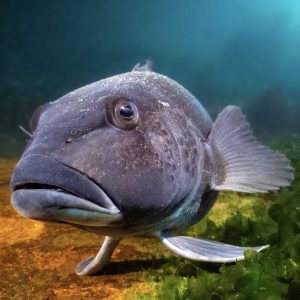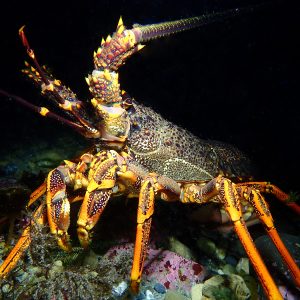
LegaSea and the New Zealand Sport Fishing Council welcome the decision by the Minister of Fisheries Stuart Nash to reduce the allowable catch for crayfish in the Hauraki Gulf and Bay of Plenty, known as the CRA 2 region.
The Minister has set the new limits for commercial fishing at 80 tonnes per year, set aside a recreational allowance of 34 tonnes and an allowance for Maori customary fishing at 16.5 tonnes.
Spokesman Richard Baker cautiously welcomes the decision, which comes after stark evidence of the collapse of the fishery. The 2017 stock assessment puts the stock at an historic low, with only 5% of male and 18% of the female population in the water now compared to the estimated size of the unfished crayfish population, “and that should be ringing alarm bells in Wellington.”
“We have been raising our concern about crayfish fisheries for a number of years. The opportunity to start rebuilding the CRA 2 stock was lost four years ago. As recently as March last year the National Rock Lobster Management Group was advising the minister that there is “no evidence of ‘sustainability issues’ with the CRA2 fishery”. Since then we’ve spoken to fishers and divers who have all said the same thing – the fishery is devastated, and decisive action is urgently needed.”
“Our recent poll on management options shows that 39% of respondents support an 80 tonne commercial fishery and 42% of respondents wanted the Minister to close the CRA 2 fishery to all fishing, for a time.”
Baker says while closure was an option there was no political appetite for such action and that the management of crayfish relies on commercial data gathering.
“It is no wonder the public is losing confidence in the Quota Management System when they see one of our most valuable fisheries on the brink of collapse having to stay open to commercial exploitation purely because there is no way to get independent data.”
The New Zealand Sport Fishing Council recently submitted that the recreational fishing public had already contributed to rebuilding the fishery because their catches had collapsed. During recent harvest surveys researchers found that 73% of all recreational fishers in CRA 2 returned with none, one or two crayfish. Less than 17% took their 6-per-day limit.
Baker says the decision to reduce the Total Allowable Catch (TAC) rests with the Minister and it is good to see him exercising this power.
“We must put the fishery first. However, there is a lingering concern that even this decision may not be enough if recruitment[i] remains at its current, historically low, level.”
The decision to reduce the total allowable commercial catch by 60% and the recreational allowance by 75% appears large on paper. However, the commercial catch limit and recreational allowance have not been caught for several years and the actual catch reduction from last year’s catch is about 30%.
A review of fishing regulations in CRA 2 is planned for later this year. This could include options for a reduced bag limit for recreational fishers and closed seasons.
Richard Baker notes the successful management of West Australian crayfish stocks using a mix of quota and pot limits to avoid the proliferation of pots in popular fishing spots, as has happened around the Coromandel and offshore islands.
Each fisher has limited units of effort and catch. Fishing stops whenever the first of these units are met.
“The pot limit prevents stock collapse, and rebuilding stocks are protected by the catch limit. A win-win for the fishery and future generations.”
Recreational fishers with an eye for the future have signed up to a Fisheries Manifesto that the government’s coalition partners supported prior to the last election. An inquiry into the Quota Management System is a priority, as is restoring depleted inshore fisheries by shifting bulk fishing methods offshore.
Baker emphasises there is a wider duty to minimise the impact of overfishing CRA 2 on the marine ecosystem with some ecologists describing crayfish as “functionally extinct” in the Hauraki Gulf. This assessment is backed up by the LegaSea recent survey and feedback from various organisations that contributed to the development of the crayfish submission to MPI. These organisations included the New Zealand Angling and Casting Association, Spearfishing New Zealand and New Zealand Underwater Association.
“When things go wrong in the pursuit of the maximum available commercial catch it can take many years to restore the natural balance. It is time for New Zealand fisheries management processes to take more account of maintaining or enhancing the ecosystem, and that’s something we strongly believe needs to change before it’s too late.”
[i] Recruitment is the number of young crayfish that grow to legal size during the year. Currently, this number is at an all-time low.
ENDS
For more information please contact:
Paul Brislen
[email protected]
021988896
References
March 2018 – Stuart Nash issues a media release – Decisions on three fish species.
March 2018 – Minister’s crayfish decisions applying from 1 April 2018.
February 2018 – Crayfish Crisis campaign. LegaSea launch a public awareness campaign using video, a survey, webinar and social media.
February 2018 – Joint recreational crayfish submission. A response to MPI proposals from the largest representative recreational fishing organisations in Aotearoa.
February 2018 – Summary of joint submission. A 2-page summary of the joint recreational submission including preliminary results from the largest ever survey of CRA 2 interests.
February 2018 – New Zealand Underwater Association submission. A response to MPI in support of the joint recreational submission for CRA 2.
February 2018 – Spearfishing New Zealand submission. A letter to MPI supporting the joint recreational submission on the crayfish proposals.
January 2018 – MPI management proposals. A discussion document proposing settings for the future management of four crayfish stocks including CRA 2.
November 2017 – MPI Crayfish Plenary. A science document including CRA 2 stock assessment and harvest information for crayfish stocks.
September 2017 – Manifesto for New Zealand’s marine inshore fisheries.
August 2016 – Crayfish ‘functionally extinct’ in the Hauraki Gulf. Article featuring marine ecologist Dr. Tim Haggitt and marine science lecturer Dr. Nick Shears.





